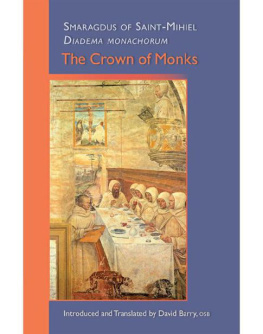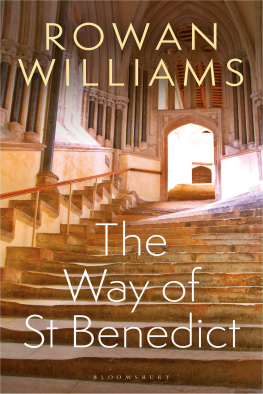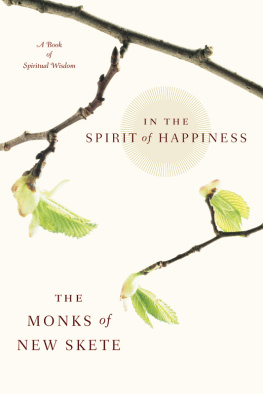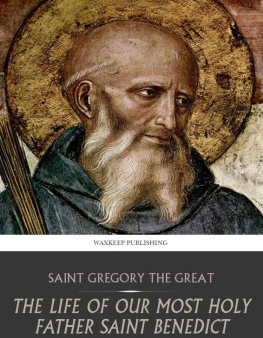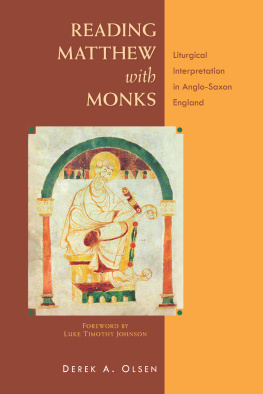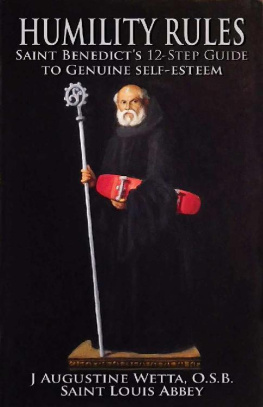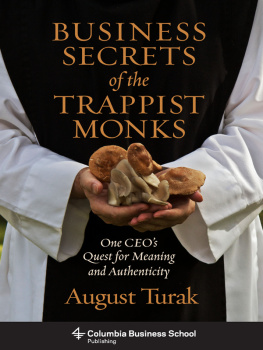CISTERCIAN STUDIES SERIES NUMBER TWO HUNDRED FORTY-FIVE
Smaragdus of Saint-Mihiel
The Crown of Monks
CISTERCIAN STUDIES SERIES NUMBER TWO HUNDRED FORTY-FIVE
Smaragdus of Saint-Mihiel
The Crown of Monks
Diadema monachorum
Introduced and
Translated
by
David Barry, OSB

LITURGICAL PRESS
Collegeville, Minnesota
www.litpress.org
A Cistercian Publications title published by Liturgical Press
Cistercian Publications
Editorial Offices
Abbey of Gethsemani
3642 Monks Road
Trappist, Kentucky 40051
www.cistercianpublications.org
Translated from Smaragdi Abbatis, Diadema Monachorum ; Smaragdi, Opera Omnia , PL 102, ed. J.-P. Migne (Petit-Montrouge: Migne, 1851), colls. 593690.
2013 by Order of Saint Benedict, Collegeville, Minnesota. All rights reserved. No part of this book may be reproduced in any form, by print, microfilm, microfiche, mechanical recording, photocopying, translation, or by any other means, known or yet unknown, for any purpose except brief quotations in reviews, without the previous written permission of Liturgical Press, Saint Johns Abbey, PO Box 7500, Collegeville, Minnesota 56321-7500. Printed in the United States of America.
The Library of Congress has cataloged the printed edition as follows:
Library of Congress Cataloging-in-Publication Data
Smaragdus, Abbot of St. Mihiel, fl. 809819.
[Diadema monachorum. English]
The crown of monks / Smaragdus of Saint-Mihiel; introduced and translated by David Barry, OSB.
pages cm. (Cistercian studies series; NUMBER 245)
Includes bibliographical references.
ISBN 978-0-87907-245-2
Ebook ISBN 978-0-87907-741-9
1. Monastic and religious lifeEarly works to 1800. 2. Benedict, Saint, Abbot of Monte Cassino. Regula. I. Barry, David, OSB, translator. II. Title.
BX2435.S5713 2013
248.8942dc23 2012046257
Dedication
Revera Deum quaerentibus
Nihil amori Christi praeponentibus
Vitam aeternam omni concupiscentia spiritali desiderantibus
Hoc opusculum interpres dedicat.
Contents
Introduction to Smaragduss Crown of Monks
T hrough his writing, and perhaps especially through his most widely read book of advice to monasticsthe Crown of Monks , presented here in English translationSmaragdus remained influential through several centuries following his death. Smaragdus (born ca. 760, died ca. 830) became Abbot of Saint-Mihiel in the early ninth century and was a monk and abbot of considerable standing in the church of his time. A supporter of Charlemagne and of his son and successor Louis the Pious, Smaragdus was active in the reform of the church during their short-lived empire. He even wrote a speculum or frstenspiegel , a mirror for princes known as the Via regia , for Louis when he was still ruling in Aquitaine. Smaragdus collaborated with Saint Benedict of Aniane in the reform of monastic life in the Carolingian empire, taking part in the Council of Aachen (816817) and drawing heavily from Benedicts hugely important Concordia regularum Further details about the life and influence of Smaragdus can be found in the three introductory essays contained in that volume. But, like Benedict, it is perhaps through his writings that we find Smaragdus most surely.
Smaragduss Diadema monachorum ( Crown of Monks ) preceded his commentary and, together, they established him as one of the most significant interpreters of Benedict in his day. Diadema made him a key voice on the spiritual and ascetical practices of monastic life for succeeding generations. The translation here is made from the Migne text in PL 102. A prominent European publisher of critical editions of patristic and medieval writings advertised a forthcoming critical edition of the Diadema in the late 1980s, but the advertisement was discontinued in the 1990s, and the edition did not reappear.
Previous scholarship on Smaragdus manuscripts also indicates his importance to monastic thought. The late Dom Willibrord Witters, monk of the Abbey of La Pierre-qui-Vire in France, made a detailed study of the diffusion of Smaragduss writings in the Middle Ages, bringing the research in this area up to the mid-1970s. At that stage the total of Smaragdus manuscripts each containing one of his works was some two hundred fourteen, with another forty-three listed in medieval library catalogues. Witters gave the number of manuscripts and catalogue listings for each of Smaragduss works century by century and showed how the larger numbers of both coincided with reform movements in monastic life (Benedictines and Cistercians) and religious life (Premonstratensians and Augustinians) that occurred in the ninth-to-tenth, twelfth, and fifteenth centuries, with fifty-three, forty-five, and thirty-three manuscripts, respectively. The most copied of the works was the Diadema monachorum , which scored one hundred fourteen manuscripts and eighteen listings in library catalogues. The provenance and date of thirty-three of these manuscripts was not ascertained at the time of Witters article. The curve of the remainder is not quite the inverse of that of the totality of the manuscripts: ninthtenth centuries (6), eleventh century (12), twelfth century (44, and 10 listings in catalogs), and fifteenth century (16). Witters also mentions something that deserves to be more widely known, at least in the world aware of the significance of manuscript tradition. Up to the time of his article, there was only one known case of a manuscript containing several of Smaragduss works, which is known as Vaticanus Reginensis lat. 190. It belonged to the great French Jesuit patrologist Dnis Ptau (15831652), and then to Queen Christine of Sweden (16261689), from whom apparently it passed into the Vatican Library. It was used by Dom Luc dAchery for his edition of the Via regia , published in Paris in a collection of ancient writers in 1661 and reproduced in Mignes PL 102; Reginensis lat. 190 was also used by Lucas Holste for the editio princeps , published in 1662, of Smaragduss De processione spiritus sancti . This very important manuscript went missing from the Vatican in 1797. One wonders in what collection it lies buried, if still extant, waiting to be rediscoveredand perhaps by a researcher in the twenty-first century.
THE DIADEMA MONACHORUM AND FLORILEGIA
The Diadema monachorum is the first of Smaragduss two extant works directed specifically to monks. He intended it as a daily resource for monastic communities. In the prologue to the Diadema , Smaragdus writes that it was already customary in monasteries observing the Rule of Benedict to have a morning community gathering (chapter) at which the Rule was read. And it was also customary to have an evening chapter, as laid down in the Rule, for the time between the evening meal and Compline, or on fast days between Vespers and Compline. Smaragdus suggests that his book, conveniently divided into one hundred chapters, be read at this evening chapter as meeting the requirements spelled out by Benedict for reading at this time (see RB 42).
The prologue also clearly states Smaragduss aim and method. He sought to provide reading material for well-established monks such that will arouse them to a keener and loftier yearning for the heavenly country, and for weak monks, to strengthen and instill fear leading them to amendment and a life more in keeping with the Rule (of Saint Benedict). His method is to cull that material (he speaks of it poetically as gathering flowers from their garden) from the conferences and lives of the (Desert) Fathers and from the writings of various doctors. Each of these sources draws heavily on the Scriptures.
Next page
